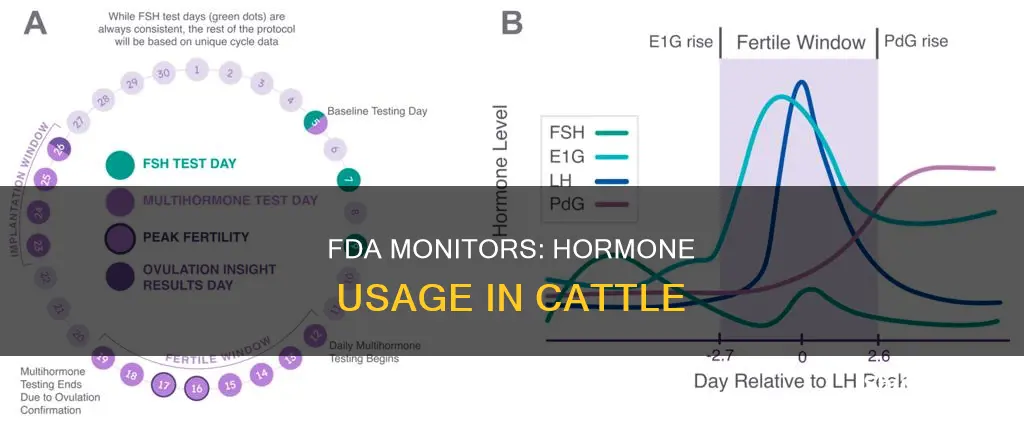
The use of hormones in cattle is a highly regulated process. The US Food and Drug Administration (FDA) has approved the use of a number of steroid hormone drugs for use in beef cattle and sheep, including natural estrogen, progesterone, testosterone, and their synthetic versions. These drugs are administered to increase the animals' growth rate and the efficiency with which they convert feed into meat. The FDA only approves these drugs after studies have shown that the meat from treated animals is safe for human consumption and that the drugs do not harm the animals or the environment. The FDA continues to monitor the safety and effectiveness of approved drugs through post-approval surveillance.
| Characteristics | Values |
|---|---|
| What | The FDA monitors the safety and effectiveness of drugs used in cattle, including steroid hormones. |
| Why | To ensure the drugs do not harm the treated animal, the environment, or the humans who will consume the meat. |
| When | The FDA monitors the drugs throughout their usage, including post-approval surveillance and review of all reported adverse drug experiences. |
| Types of Drugs Monitored | Steroid hormones, including natural estrogen, progesterone, testosterone, and their synthetic versions. |
| How Administered | As pellets or “implants” that are placed under the skin on the back side of the animal’s ear. |
| Who Administers | Livestock producers administer the drugs at specific stages of the animals’ growth. |
What You'll Learn
- Hormone usage in cattle increases growth rate and feed conversion efficiency
- The FDA approves the use of hormones in cattle only after studies have shown that the meat from the treated animals is safe for human consumption
- The FDA also ensures that the drugs do not harm the treated animal or the environment
- The FDA approves the use of natural hormones estradiol, progesterone, and testosterone, as well as their synthetic versions
- Hormone implants are placed under the skin on the backside of the animal's ear

Hormone usage in cattle increases growth rate and feed conversion efficiency
The use of hormones in cattle has been a topic of interest for many years, with the first instances of hormonal intervention in cattle recorded in the 1930s and 1940s. The primary purpose of hormonal intervention in cattle is to increase their growth rate and feed conversion efficiency, resulting in a higher yield of meat per animal.
Types of Hormones Used
The Food and Drug Administration (FDA) has approved the use of several steroid hormones for this purpose, including natural estrogen, progesterone, testosterone, and their synthetic versions. These hormones are typically administered as implants placed under the skin on the backside of the animal's ear.
Benefits of Hormone Usage
The use of hormones in cattle offers several benefits. Firstly, it increases the animal's growth rate, resulting in larger animals and a higher yield of meat. Secondly, it improves feed conversion efficiency, meaning the animals require less feed to gain weight, reducing the resources needed per pound of meat produced. This increase in efficiency not only benefits farmers economically but also contributes to a more sustainable food production system.
Safety Regulations
The FDA closely monitors the safety and effectiveness of hormonal implants. Before approving any drug for use in food-producing animals, the FDA conducts extensive studies to ensure that the meat from treated animals is safe for human consumption and that the drug does not harm the animals or the environment. The FDA also requires clear and approved labeling for each product, providing instructions for safe and effective use.
Consumer Concerns
Despite the regulations in place, there are still consumer concerns surrounding the use of hormones in cattle. One common myth is that hormone-implanted beef is unsafe to consume. However, the U.S. Food and Drug Administration regulates the development and use of hormone implants, and the Food Safety Inspection Service of the USDA routinely monitors residues of synthetic hormones in meat.
It is important to note that there is no such thing as "hormone-free" beef, as hormones are naturally occurring and essential for the animal's survival. However, consumers can choose to purchase beef with labels such as "no added hormones administered" or "raised without added hormones," which indicates that no additional hormones were used beyond what is naturally occurring.
In conclusion, the use of hormones in cattle has been proven to increase growth rates and feed conversion efficiency. The FDA closely monitors the safety and effectiveness of these practices, ensuring that the benefits are achieved without compromising the health of the animals or consumers.
How Closely Does Comporium Monitor User Activity and Bandwidth?
You may want to see also

The FDA approves the use of hormones in cattle only after studies have shown that the meat from the treated animals is safe for human consumption
The FDA has approved a number of steroid hormone drugs for use in beef cattle and sheep since the 1950s. These include natural estrogen, progesterone, testosterone, and their synthetic versions. These drugs increase the animal's growth rate and the efficiency with which they convert feed into meat. The FDA only approves these drugs after studies have demonstrated that they do not harm the treated animal or the environment and that the meat from the treated animals is safe for human consumption.
The process of approving an animal drug for food-producing animals is meticulous and comprehensive. The FDA evaluates numerous studies before approval to determine the safety of the drug for the treated animals, the safety of animal products (edible tissues such as meat and milk) for human consumption, and the effectiveness of the drug. The FDA also publishes public documents, known as Freedom of Information Summaries, that summarise the information used to determine the safety and effectiveness of the drug.
One example of an FDA-approved drug is Posilac, a bovine somatotropin (bST) product approved in 1993. bST is a protein hormone essential for normal growth, development, and health maintenance in animals, including humans. The FDA approved Posilac after determining that its use would be safe and effective, and it continues to monitor the drug's safety and effectiveness through post-approval surveillance.
The safety of hormone usage in cattle is a well-studied and regulated area. The FDA's approval process ensures that the meat from treated animals is safe for human consumption, and there are strict guidelines in place for consumers to understand and make informed choices.
Monitoring Resource Usage: Strategies for Efficient Startup Management
You may want to see also

The FDA also ensures that the drugs do not harm the treated animal or the environment
The FDA ensures that the drugs do not harm the treated animal or the environment by evaluating the results of numerous studies before approval. The FDA also continues to monitor the safety and effectiveness of the drugs through post-approval surveillance and review of all reported adverse drug experiences.
The FDA approved an animal drug for food-producing animals only after information and/or studies have shown that the food from the treated animals is safe for people to eat, and that the drugs do not harm the treated animal or the environment. The drugs also have to be effective, meaning that they work as intended. The FDA evaluates the effects of treatment on all aspects of the animals' health, feed intake, ability to reproduce, and the health of their offspring. The FDA also ensures that the drugs do not have any toxicological or microbiological impacts and identifies acceptable consumption levels that the compounds should not exceed.
The FDA publishes public documents (Freedom of Information Summaries) on its website that summarize the information that the administration used to determine that the drug is safe for the treated animals, the animal products (edible tissues such as meat and milk) are safe for humans to eat, and that the product is effective.
For example, the FDA approved a bST product in 1993 with the brand name “Posilac™” (sometribove zinc suspension) after determining that its use would be safe and effective. Posilac™ is approved for over-the-counter use in dairy cows starting at around 2 months after the cow has a calf until the end of the lactation period. During this time, cows are injected with Posilac™ subcutaneously (under the skin) every 14 days. A cow’s typical lactation period is approximately 10 months long, starting right after she has a calf. Thus, treated dairy cows are typically given Posilac™ for about 8 months of the year. After the 10-month lactation period, the producer stops milking the cow to allow a 2-month period for her mammary gland to rest and regenerate before she has a calf and starts the next lactation period.
The FDA also ensures that the drugs do not harm the environment by establishing acceptable safe limits for hormones in meat. The acceptable level for human consumption is a level of drug in the meat that would be expected to have no harmful effects on humans based on extensive scientific study and review.
Monitoring App Data Usage: Take Control of Your Mobile Data
You may want to see also

The FDA approves the use of natural hormones estradiol, progesterone, and testosterone, as well as their synthetic versions
The Food and Drug Administration (FDA) has approved the use of certain steroid hormone drugs in beef cattle and sheep since the 1950s. This includes the natural hormones estradiol (estrogen), progesterone, and testosterone, as well as their synthetic versions. These drugs are designed to increase the growth rate of the animals and improve the efficiency of feed conversion into meat.
The FDA only approves these drugs after studies have demonstrated their safety for human consumption and their effectiveness in the target animals. The administration also ensures that the drugs do not harm the treated animals or the environment. The labelling for each product provides instructions for safe and effective use, and the FDA makes this information publicly available via Freedom of Information Summaries on its website.
The approved steroid hormone drugs are typically formulated as pellets or implants that are placed under the skin on the backside of the animal's ear. These implants slowly dissolve and do not require removal. However, the treated animal's ears are discarded during slaughter and are not intended for human food.
The use of these hormones in cattle is safe for humans because the additional hormone levels following drug treatment are relatively small compared to the amount of natural hormones found in the meat of untreated animals and those produced in the human body. The FDA establishes acceptable safe limits for hormones in meat based on extensive scientific study and review.
It is important to note that the FDA does not approve the use of steroid hormone implants in dairy cows, veal calves, pigs, or poultry for growth purposes.
Monitoring Your Dryer's Electricity Usage: A Step-by-Step Guide
You may want to see also

Hormone implants are placed under the skin on the backside of the animal's ear
The Food and Drug Administration (FDA) has approved the use of steroid hormone drugs in beef cattle and sheep since the 1950s. These drugs, which include natural estrogen, progesterone, testosterone, and synthetic versions, are designed to increase an animal's growth rate and the efficiency of converting feed into meat. The FDA only approves these drugs after studies have shown that the meat from treated animals is safe for human consumption, and that the drugs do not harm the animals or the environment.
These steroid hormone drugs are typically formulated as pellets or "implants" that are placed under the skin on the backside of the animal's ear. This process is done using a specific applicator, known as an implant gun, which properly administers the implant. The implants slowly dissolve under the skin and do not need to be removed. The treated animal's ears are discarded during slaughter and are not used for human food.
The FDA establishes acceptable safe limits for hormones in meat based on extensive scientific study and review. The approved drugs may be natural hormones, such as estradiol (estrogen), progesterone, and testosterone, which are necessary for normal development, growth, and reproduction in both humans and animals. The amount of additional hormones following drug treatment is relatively small compared to the amount of natural hormones found in the meat of untreated animals and those produced in the human body.
To ensure the safety of consumers, the FDA requires toxicological testing and the demonstration of safe levels of hormones in edible tissues before approving synthetic versions of natural hormones, such as trenbolone acetate and zeranol.
The placement of hormone implants under the skin on the backside of the animal's ear is a precise procedure that requires proper sanitation and restraint of the animal. It is important to follow the manufacturer's recommendations and ensure that the equipment is clean and sanitized to minimize the risk of implant defects and abscesses.
Monitoring Memory Usage: EMR Spark Management Strategies
You may want to see also
Frequently asked questions
The hormones are used as growth promoters to increase the animals' growth rate and the efficiency by which they convert the feed they eat into meat.
The hormones are administered in the form of small pellets, termed 'implants', that are placed under the skin in the animal's ear.
The FDA approves the use of these drugs only after studies have shown that the food from the treated animals is safe for human consumption, and that the drugs do not harm the treated animal or the environment.
It is important to understand that there is no such thing as "hormone-free" beef. Hormones are naturally occurring and are essential for the survival of the animal. There are, however, products available from beef that have not been administered additional hormones, and these may be labelled as "raised without added hormones".
The boost in growth rate created by hormone implants allows for cattle to be finished earlier, thereby requiring less time on feed and fewer resources per pound of meat produced.







